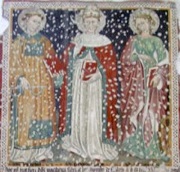

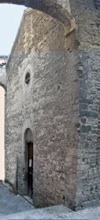
This Romanesque church is one of the oldest parish churches in the city. It was built in two phases:
-
✴The small crypt (11th century), which is reached from steps on the right, was originally a separate church that had been built on Roman foundations.
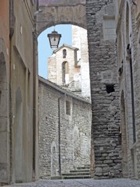
-
✴The present, larger church was built over it in the 12th century. An inscription in the presbytery records its consecration in 1174.
It is sometimes possible to visit the church by arrangement with the Galleria Civica d’ Arte Moderna.
Exterior
The main facade is undecorated except for its small rose window.
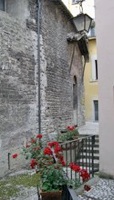
Madonna and Child with saints (12th century)
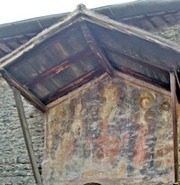
Interior
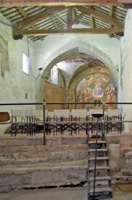
The church contains important frescoes, many of which date to the late 12th and early 13th centuries. Some of them are by the so-called Alberto Sotio and his circle. In particular, he signed and dated a Crucifix (1187) in the church that is now in the Duomo (see below).
Left Wall
Martyrdom of St Thomas à Becket (ca. 1230)
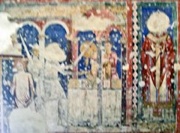
Assumption of the Virgin and St Francis (ca. 1300)
This damaged fresco comprises two scenes:
-
✴The Assumption of the Virgin is to the right. It depicts the moment at which she gives her girdle to St Thomas.
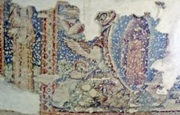
-
✴St Francis points to the scene from the left. He holds his own rope girdle (a symbol of poverty) in his right hand.
Some authors claim this as an early image of St Francis that is based on the description given by his biographer, Thomas of Celano. However, the later date suggested above is more usually accepted by modern critics.
SS Leonard, Gregory and Catherine of Alexandria (1445)
Dance of Salome (ca. 1200)
This fresco fragment was part of a larger depiction of the feast of Herod.
Presbytery
The wooden high altar (late 12th century) was originally in the crypt.
Annunciation and the Flagellation of Christ (ca. 1300)
These frescoes high up on the altar wall were hidden when the ceiling of the presbytery was lowered in the late 15th century. They are the only works attributed to the Maestro delle Palazze except for his autograph work from Santa Maria inter Angelos, Le Palazze (see Walk III).
Frescoes (16th century)
This fresco in the presbytery by Pier Matteo Piergili depict:
-
✴the Madonna and Child with SS John the Baptist, John of Spoleto, Joseph, John (as in John and Paul), Jerome, Antony of Padua, Mary Magdalene and Paul (as in John and Paul) on the altar wall; and
-
✴the Evangelists in the vaults.
Right Wall
Two Bishop Saints (13th century)
This fragment near the arch of the presbytery originally formed part of a larger work.
SS Michele, Margherita e Taddeo (ca. 1200)
This fresco is by a follower of Alberto Sotio.
Works from the Church
Christus Triumphans (1187)
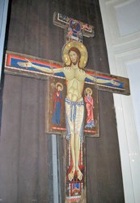
Martyrdom of SS John and Paul (late 12th century)

